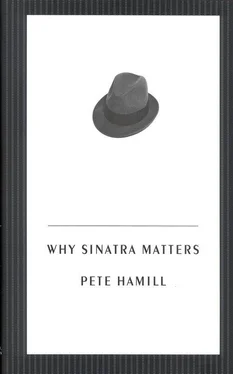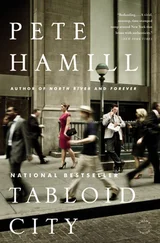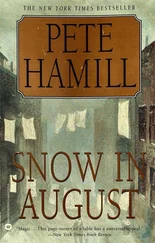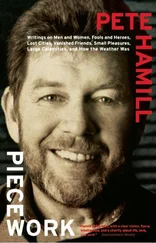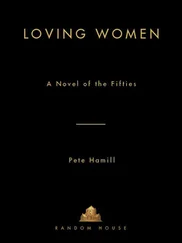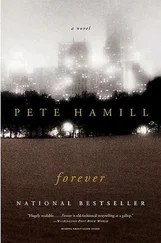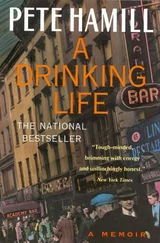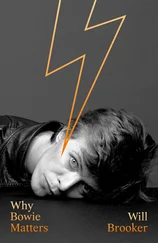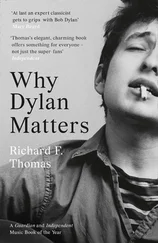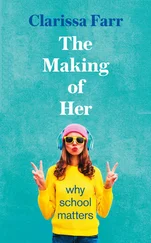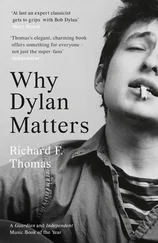“With Harry, for the first time in my life I was with people who thought the sky was the limit,” he said to me later. “They thought they could go to the top, and that’s what they aimed for. They didn’t all make it, but what the hell. They knew the only direction was up.”
On July 13, 1939, he went into a recording studio for the first time and made two recordings with the James band: “From the Bottom of My Heart” and “Melancholy Mood.” A month later he recorded “My Buddy” and “It’s Funny to Everyone but Me.” Then in September he recorded “Here Comes the Night” and a song by Jack Lawrence and Arthur Altman called “All or Nothing at All.” The first release of the last song sold 8,000 copies. A few years later, after he was established as a star, it would be re-released during a musicians’ strike and sell a million. On the earliest recorded vocals with the James band, Sinatra sounds uncertain, unformed, but he does have a distinctive voice. It is certainly not another imitation of Crosby. But on each succeeding date, he gets closer to what he will become, expressing the feeling of loneliness in a new way, within the context of a modern swing band. Those earliest records are like talented first drafts of a good first novel.
Near the end of the year, after only six months with James, Sinatra got an even bigger break: Tommy Dorsey came calling. The Dorsey orchestra was considered the smartest, toughest, hippest of the white swing bands. Some made the same case for Goodman, of course, calling him the King of Swing, but the argument for the Dorsey band was based on its flexibility. Both could do pulsing, vibrant, riff-driven swing pieces; Dorsey could also handle smooth ballads, which Goodman did not do well. (Most musicians of the era thought that the Glenn Miller sound was safe, mechanical, corny.) Dorsey was himself a fine trombone player, in a sweet legato style; he employed first-rate arrangers, such as Sy Oliver (from the Jimmie Lunceford band), Axel Stordahl, Bill Fine-gan, and Paul Weston, and superb musicians, including the trumpet player Bunny Berigan, whose talent was legendary but who would soon be destroyed by alcohol. Sinatra had inadvertently auditioned for Dorsey several years before he landed the job with Harry James. He showed up to audition for a swing band led by a man named Bob Chester. He later told Douglas-Home what followed:
“I had the words on the paper there in front of me and was just going to sing when the door opened and someone near me said, ‘Hey, that’s Tommy Dorsey!’ He was like a god, you know. We were all in awe of him in the music business. Anyway, I just cut out completely — dead. The words were there in front of me, but I could only mouth air. Not a sound came out. It was terrible.”
Sinatra didn’t get the job with Bob Chester. But near the end of 1939 Tommy Dorsey’s star vocalist, Jack Leonard, quit after a dispute, went off on his own, did poorly, and was eventually drafted. The war in Europe was already four months old, tensions were increasing in the western Pacific, and the United States was getting ready for its own inevitable entry into the war, twenty years after young Frank Sinatra saw those triumphant victory parades in Hoboken. Dorsey had heard the Harry James records (Jack Leonard, in fact, had played “All or Nothing at All” for him) and sent for Sinatra.
“The first thing he said was, ‘Yes, I remember that day when you couldn’t get out those words.’”
Dorsey signed him to a long-term contract for $125 a week, which Sinatra needed since Nancy was now pregnant with their first child. But it wasn’t easy to leave Harry James. The handsome, mustached trumpet player also had a contract with Sinatra, but he was a decent man; he knew his own band wasn’t making money and that Dorsey, a “rich” band, could pay the young singer steadily and well. He tore up his contract and wished Sinatra all the luck in the world. They were still friends when James died in 1983.
“That night the bus pulled out with the rest of the boys at about half-past midnight,” Sinatra later told Douglas-Home. “I’d said goodbye to them all, and it was snowing, I remember. There was nobody around and I stood alone with my suitcase in the snow and watched the taillights disappear. Then the tears started and I tried to run after the bus.”
He didn’t catch it. The James band went to play a gig in Hartford, and Sinatra took a train to New York. From there he went off to three years of school at Dorsey University. Every night he listened to, and learned from, some of the best musicians in the country: pianist Joe Bushkin, drummer Buddy Rich, Berigan and his replacement as lead trumpet, Ziggy Elman (a defector from the Goodman band). Sy Oliver taught Sinatra how to ride or glide over the rhythm base of a tune, not repeat it in his vocals, which was a kind of musical redundancy. Like Sinatra, these musicians had all been formed by Prohibition and the Depression, and the new vocalist liked their style. They were hard-drinking, tough-talking, and dedicated to the music. They smoked cigarettes. They chased women. They gambled. They cursed. And they played at the top of their talent, or were sent packing by the remorseless Dorsey.
Sinatra started as one of the Pied Pipers, the band’s singing group, whose female star was Jo Stafford. She later remembered Sinatra, walking on stage for the first time, as “a very young, slim figure with more hair than he needed. We were all sitting back — like, ‘Oh, yeah, who are you?’ Then he began to sing.” After four bars Stafford knew that she had better listen closely. She thought, “Wow! This is an absolutely new, unique sound.” As she elaborated later: “Nobody had ever sounded like that. In those days most male singers’ biggest thing was to try and sound as much like Bing as possible. Well, he didn’t sound anything like Bing. He didn’t sound like anybody else that I had ever heard.”
Sinatra swiftly gained the respect of the other members of the band, even those who were friends of the departed Jack Leonard. He had a variety of troubles with Buddy Rich, a loner who considered himself the band’s feature attraction, with some reason (many consider him the greatest white drummer of the century). Sinatra even heaved a water pitcher at Rich backstage, sending shards of broken glass scattering and splashing Stafford. But they were also friends, rooming together on the road, where Sinatra would absorb Rich’s knowledge of rhythm and tempo. As his confidence grew, Sinatra strengthened and refined his technique by listening to all the musicians, but above all to Dorsey. And he made records with the band. The first two were recorded on February 1, 1940 (“The Sky Fell Down” and “Too Romantic”); eighty-one others would follow.
It wasn’t always easy. The son of a music teacher, Dorsey was Irish, tough, something of a martinet. A few years earlier he had fought with his older brother, Jimmy, another fine musician, and broke up their band to go off on his own. Tommy built his own orchestra into a commercial and artistic success through a combination of will and musicianship. He built his sound around his own sweet trombone playing, as exemplified by his theme, “I’m Getting Sentimental Over You,” but also willingly turned the spotlight over to soloists and vocalists. He insisted on perfection from the band members and had no tolerance for the unkempt semi-bohemian styles that many musicians affected. He wanted his men to be clean-shaven and even held inspections before gigs. For the most part, the men responded; the members of the Dorsey band swaggered a bit, convinced of their superiority over other bands. But Dorsey, like Buddy Rich, was also a loner. That quality obviously touched Sinatra in ways that had nothing to do with music.
“Tommy was a very lonely man,” Sinatra told Douglas-Home. “He was a strict disciplinarian with the band — we’d get fined if we were late — yet he craved company after the shows and never really got it. The relationship between a leader and the sidemen, you see, was rather like a general and privates. We all knew he was lonely, but we couldn’t ask him to eat and drink with us because it looked too much like shining teacher’s apple.”
Читать дальше
